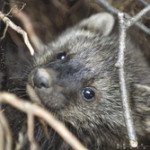Going about my business in the backyard, I was suddenly surrounded by deer. About a dozen in number, they were all around the yard, though the sunflower seeds scattered beneath the birdfeeders were their likely destination. The deer were intently watching me, but they didn’t appear wary or afraid. One scruffy fawn even approached me. She and the rest of the herd wanted something to eat.
We haven’t put out food for the deer in many years, because they became a year-round nuisance when we did. However, lots of people do feed deer along the North Shore in the winter or even year-round. Deer that migrate to the winter yards along the Shore are conditioned to eat shelled corn and other artificial goodies.
In our backyard, we have bird feeders and a compost heap. Both attract foraging deer. Therein lies a conundrum. While there is a growing belief that feeding deer increases the risk of disease and likely leads to greater—and often undesired—whitetail abundance, it is hard to draw a line at what is and what isn’t deer feeding. We don’t want to feed deer, but they come anyway for the goodies in the compost heap and beneath the bird feeder.
While January offered some reprieve from the white stuff, snow lies deep across the northwoods. The deer are traveling on trails and seem to be getting around just fine, but a lot of winter remains. By many accounts, wolves are numerous, too. We may be just a blizzard away from a killer winter.
If so, we are likely to see the deer-feeding debate rekindled. In the past, most recently in the mid 1990s, the Minnesota DNR has very reluctantly provided food for winter-stressed deer. The agency claims that it cannot possibly provide enough food to make a difference and occasional harsh winters are Nature’s way of keeping the deer population balanced with its environment. Many deer hunters and deer lovers disagree.
Feeding may make a difference on a small scale, but deer losses are inevitable during harsh winters. The irony is that a hard winter comes without warning, usually after a string of mild or moderate winters allow northern deer numbers to increase. Just about the time everyone starts taking this whitetail horn of plenty for granted (whether or not they deer abundance is a good thing), Old Man Winter makes a grim harvest.
We can expect some deer losses during a heavy snow year such as this one, but the extent of those losses will largely be determined by the weather we experience between now and mid April. If we get more snow, and it lingers into the spring, there will be noticeably fewer deer in the woods next fall. However, the weather so far hasn’t been anything like the extreme winter of 1995-96. As I recall, we received two 18-inch blizzards in January during that winter, as well as lengthy periods of bitterly cold temperatures. Snow on the ground lasted well into May. We don’t appear to be on track for similar severity this year.
Nevertheless, winter seems endless in early February. But take heart, now is the time to find the first, faint signs of spring. You’ve probably noticed the sun is climbing higher in the sky and the days are growing longer. Northern critters are beginning to stir. On a recent morning I noticed fresh fox tracks in the yard and smelled the distinctive, pungent urine of a lonesome fox. I heard my first owl the other night. Before the month is over, I’ll be listening to breeding owls calling nearly every night, the ravens will be mating, and wolves will be on the roam.



